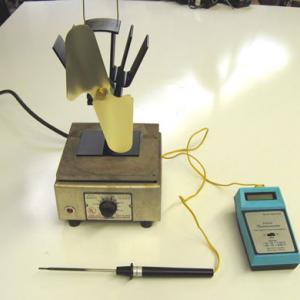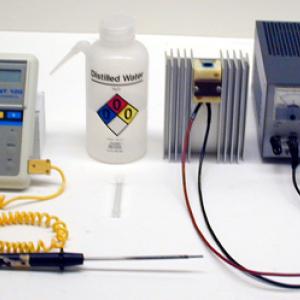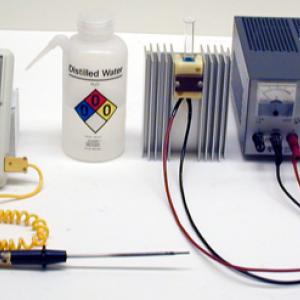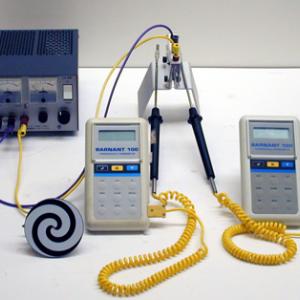College of Liberal Arts & Sciences
5E50.60 - Thermoelectric Cooler/Peltier Apparatus
Turn the hot plate up to 500 which should bring the temperature of the hot plate to around 330 degrees Fahrenheit or 165 degrees Celsius and just leave it on. When you get ready, place the fan on top of the hotplate. The fan should start to turn in less than two minutes.
Note: The fan has an operating temperature between 170 degrees Fahrenheit or 76 degrees Celsius and 475 degrees Fahrenheit or 245 degrees Celsius. Below 76 degrees Celsius the fan will not turn and above 245 degrees Celsius the Peltier device in the fan will be destroyed.
Place some water into the test tube. Insert the tube into the recess of the thermoelectric cooler. Turn on the voltage to about 6 Volts and adjust the amperage to about 12 Amps. The water should freeze in 5 to 10 minutes. A thermometer may be used in place of the test tube and water.
The reversible thermoelectric demonstrator can be used in a variety of different ways.
Attach the motor to the demonstrator and then place one leg in hot water and one leg in cold water. After several minutes the motor will start to turn due to the heat differential being turned into electrical current.
Detach the electric motor and plug in a voltmeter when doing the above experiment.
Detach the motor and plug in a 0 to 20 Volt power supply. Attach a digital thermometer to each leg and turn the power supply up to 6 Volts. One leg will become warmer than room temperature while one becomes cooler than room temperature.
The CPU Peltier device runs on 6 Volts DC and 1.5 Amps. When initially switched on the thermometer should show a temperature in the mid 30 degrees Fahrenheit after 15 seconds.
- Rong Bai, Shuaishi Liu, Taiting Liu, Zhongbo Sun, Yufeng Lian, Keping Liu, "Demonstration of Thermoelectric Power Generation with a Thermoelectric Cooler", TPT, Vol. 60, #7, Oct. 2022, p. 586.
- Min Chen, Lasse Rosendahl, Inger Bach, Thomas Condra, and John Pedersen, "Irreversible Transfer Processes of Thermoelectric Generators", AJP, Vol. 75, #9, Sept. 2007, p. 815.
- A. J. Mortlock, "Experiments with a Thermoelectric Heat Pump", AJP, Vol. 33, #10, Oct. 1965, p. 813.
- R. Mark Wilson, "Heating and Cooling with Electron Spins", Physics Today, Vol. 65, #5, May 2012, p. 19.
- Gerald Mahan, Brian Sales, and Jeff Sharp, "Thermoelectric Materials: New Approaches to an Old Problem", Physics Today, Vol. 50, #3, Mar. 1997, p. 42.
- Yu Xiao & Li-Dong Zhao, "Seeking New, Highly Effective Thermoelectrics", Science, Vol. 367, # 6483, March 13, 2020, p. 1196.
- Jun Mao, Hangtian Zhu, Zhiwei Ding, Zihang Liu, Geethal Amila Gamage, Gang Chen, and Zhifeng Ren, "High Thermoelectric Cooling Performance of N-Type Mg3Bi2-Based Materials", Science, Vol. 365, #6452, Aug. 2019, p. 495.
- G. D. Freier and F. J. Anderson, "Et-2. Thermoelectric Cooler", A Demonstration Handbook for Physics.
- Richard Manliffe Sutton, "E-180. Peltier Effect", Demonstration Experiments in Physics, p. 323.
- Yaakov Kraftmakher, "7.17. Two-Stage Peltier Cooler", Experiments and Demonstrations in Physics, ISBN 981-256-602-3, p. 487.
- Yaakov Kraftmakher, "5.8. Thermoelectric Phenomena", Experiments and Demonstrations in Physics, ISBN 981-256-602-3, p. 349.
- Cunningham and Herr, "8.2.3. Electric Energy from Heat", Hands-On Physics Activities with Real Life Applications.
Disclaimer: These demonstrations are provided only for illustrative use by persons affiliated with The University of Iowa and only under the direction of a trained instructor or physicist. The University of Iowa is not responsible for demonstrations performed by those using their own equipment or who choose to use this reference material for their own purpose. The demonstrations included here are within the public domain and can be found in materials contained in libraries, bookstores, and through electronic sources. Performing all or any portion of any of these demonstrations, with or without revisions not depicted here entails inherent risks. These risks include, without limitation, bodily injury (and possibly death), including risks to health that may be temporary or permanent and that may exacerbate a pre-existing medical condition; and property loss or damage. Anyone performing any part of these demonstrations, even with revisions, knowingly and voluntarily assumes all risks associated with them.





